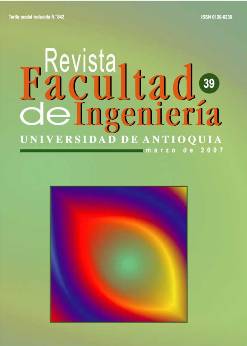Univariant time series analysis applied to ozone forecasting in the city of Cali, Colombia
DOI:
https://doi.org/10.17533/udea.redin.20192Keywords:
atmospheric pollution, air quality urban ozone, time series analysis, univariate time series analysisAbstract
The modelling results of tropospheric ozone concentration in the urban area of Cali, Colombia, suitable for short term forecasting, are presented. Results were obtained by using an univariate time series analysis. The method was applied to a series of 2496 hourly ozone concentration data from one of the city’s air quality monitoring network stations. Data were collected from April to July of 2003. A total of 104 consecutive days were covered: the first 93 days were used for model estimation, and the remaining 11 days for model validation. This technique can be used to predict (up to 8 hours) in advance high-ozone levels, allowing the environmental authorities to issue alerts to the population for possible air-quality impact on health.
Downloads
References
J. H. Lucio. Desarrollo de modelos estocásticos lineales univariantes y multivariantes para la comprensión y predicción del ozono troposférico en atmósfera urbana. Tesis doctoral, Universidad de Valladolid: Valladolid. 2003. pp. 65-82.
J. C. García. Predicción del máximo de ozono utilizando metodología ARIMA sobre los datos monitorizados de calidad de aire de Valladolid. Servicio del medio, Ayuntamiento de Valladolid: Valladolid 2003. pp. 1-8
G. E. P. Box, G. M. Jenkins, G. C. Reinsel. Time Series Analysis. Forecasting and Control: New Jersey Prentice Hall. 3.rd edition.1994. pp. 55-98
C. Chatfield. The Analysis of Time Series: An Introduction. 6.th ed. Bath. Chapman & Hall/CRC. 2004. pp. 46-262.
R.W. Boubel, D. Fox, D.B Turner. Fundamentals of Air Pollution. 3.th ed. Washington. Academic Press. 1994. pp. 165-178 DOI: https://doi.org/10.1016/B978-0-08-050707-1.50016-0
W. Enders. Applied Econometric Time Series. 2.nd ed. Alabama. Wiley. 2004. pp. 52-68.
R. S. Pindyck, D. L. Rubinfeld. Econometría: Modelos y Pronósticos. México. McGraw-Hill Interamericana. 2001. pp. 404-410.
Downloads
Published
How to Cite
Issue
Section
License
Revista Facultad de Ingeniería, Universidad de Antioquia is licensed under the Creative Commons Attribution BY-NC-SA 4.0 license. https://creativecommons.org/licenses/by-nc-sa/4.0/deed.en
You are free to:
Share — copy and redistribute the material in any medium or format
Adapt — remix, transform, and build upon the material
Under the following terms:
Attribution — You must give appropriate credit, provide a link to the license, and indicate if changes were made. You may do so in any reasonable manner, but not in any way that suggests the licensor endorses you or your use.
NonCommercial — You may not use the material for commercial purposes.
ShareAlike — If you remix, transform, or build upon the material, you must distribute your contributions under the same license as the original.
The material published in the journal can be distributed, copied and exhibited by third parties if the respective credits are given to the journal. No commercial benefit can be obtained and derivative works must be under the same license terms as the original work.










 Twitter
Twitter